Why Physics Needs, And Deserves, A Post-LHC Collider
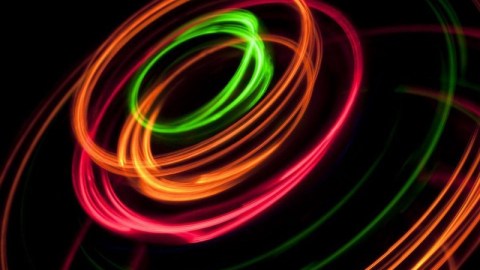
The Large Hadron Collider allowed us to complete the Standard Model. Even so, what we have is incomplete. Here’s what could come next.
The Large Hadron Collider is the most powerful particle accelerator ever built by humanity. By achieving higher energies and greater numbers of collisions at those energies than ever before, we’ve pushed the frontiers of particle physics past their old boundaries. The achievements of the thousands of scientists who’ve built the LHC and its detectors, run the experiments, and collected and analyzed the data cannot be overstated.
It’s best known for finding the Higgs boson, but nothing outside the Standard Model. Some even consider what the LHC has found disappointing, because we haven’t yet discovered any novel, unexpected particles. But this obscures the biggest truth in experimental science of any type: to truly know the fundamental nature of the Universe, you must ask it questions about itself. At present, the LHC is our best tool for doing that, along with its upcoming high-luminosity upgrade. If we want to continue learning, we must prepare to go beyond the LHC, too.
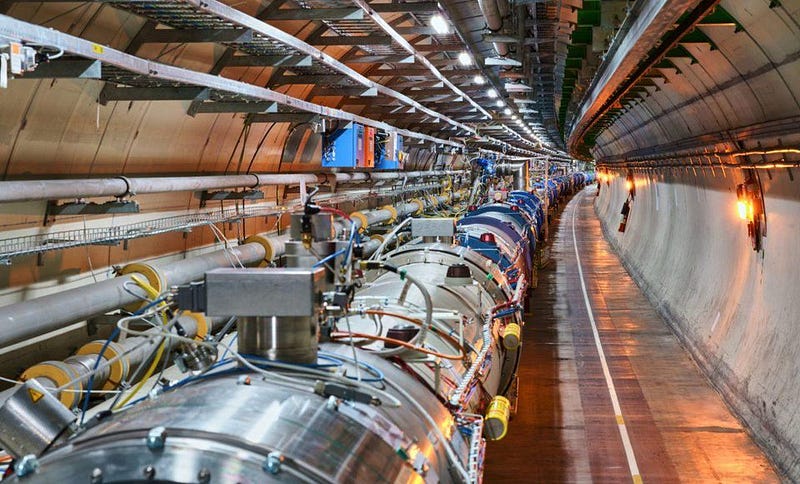
The reason the LHC is such a powerful tool isn’t simply for the data it collects. Sure, it collects an incredible amount of data, by colliding bunches of protons into other bunches of protons at 99.999999% the speed of light every few nanoseconds. The collisions result in debris that scatters through the enormous detectors constructed around the collision points, recording the outgoing particle tracks and enabling us to reconstruct what was created, and how.
But there’s another critical component to that story: understanding the Standard Model of elementary particles. Every particle in the Universe obeys the laws of particle physics, which means there are couplings and interactions between particles, both real and virtual.
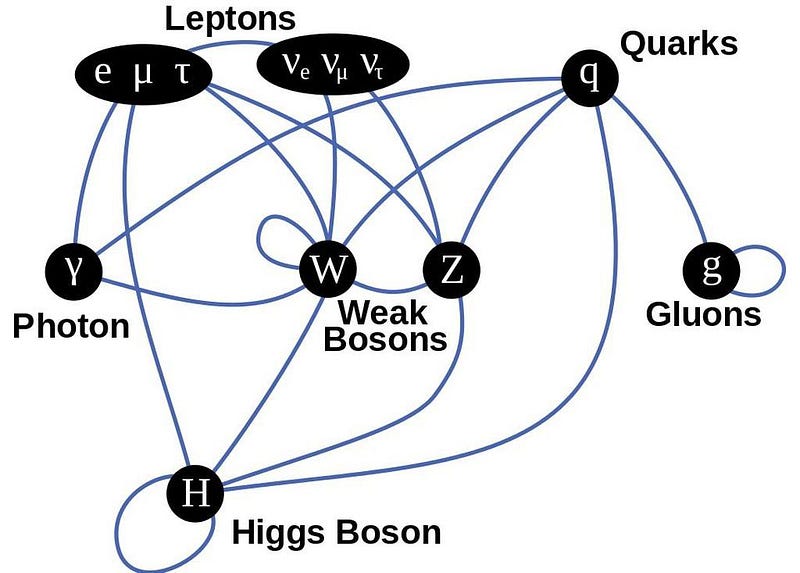
Have mass? You couple to the Higgs. This includes the Higgs boson, which couples to itself.
Have electric, weak, or strong charges? You couple to the appropriate bosons: the photons, W-and-Z, or gluons, respectively.
And that’s not the end, as everything that those bosons couple to also play a role. For example, the proton is made of three quarks: two up quarks and a down quark, which couple to the strong force via the gluons. Yet if we changed the mass of the top quark from 170 GeV to about 1000 GeV, the proton’s mass would increase by about 20%.

In other words, the properties of the particles that we know of depend on the full suite of all the other particles out there, even the ones we haven’t detected yet. If we’re looking for something beyond the Standard Model, the most obvious way is to create a new particle and simply find it.
But what we’re far more likely to do in practice is to:
- create large numbers of particles that we already know of,
- compute what things like decay rates, branching ratios, scattering amplitudes, etc., are for the Standard Model alone,
- measure what those decay rates, branching ratios, scattering amplitudes, etc., actually are,
- and compare with the predictions of the Standard Model.
If what we observe and measure is identical to what the Standard Model predicts, then anything new — and we know there are new things that must exist in the Universe — doesn’t modify our observables by more than the measurement uncertainty. So far, that’s what all the colliders up through the LHC have revealed: particles that behave in perfect accord with the Standard Model.
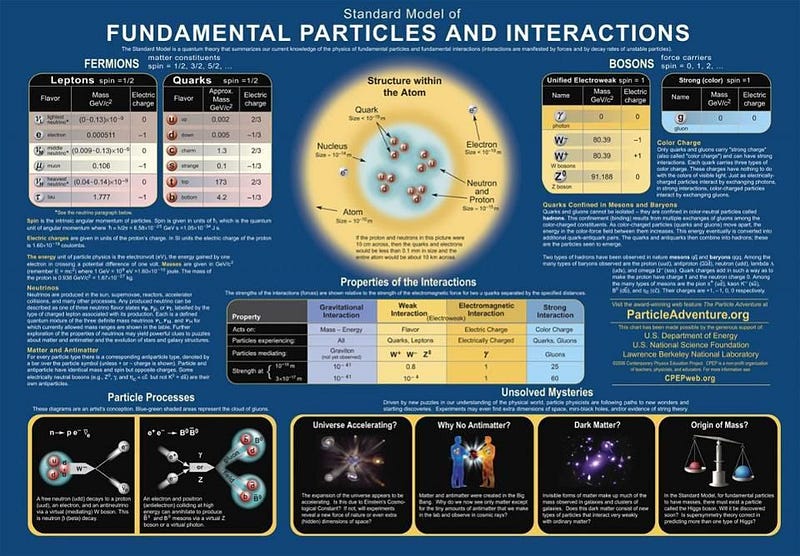
But there must be new particles out there, and they might be detectable by pushing the frontiers of experimental particle physics. The options include new physics, new forces, new interactions, new couplings, or any slew of exotic scenarios. Some of them are scenarios we haven’t even yet envisioned, but the dream of particle physics is that new data will lead the way. As we peel back the veil of our cosmic ignorance; as we probe the energy and precision frontiers; as we produce more and more events, we start obtaining data like we’ve never had before.
If we can look at meaningful data that takes us from 3 to 5 to 7 decimal places, we start becoming sensitive to couplings to particles that we cannot create. The signatures of new particles can show up as a very small correction to the Standard Model’s predictions, and creating huge numbers of decaying particles like Higgs bosons or top quarks could reveal them.
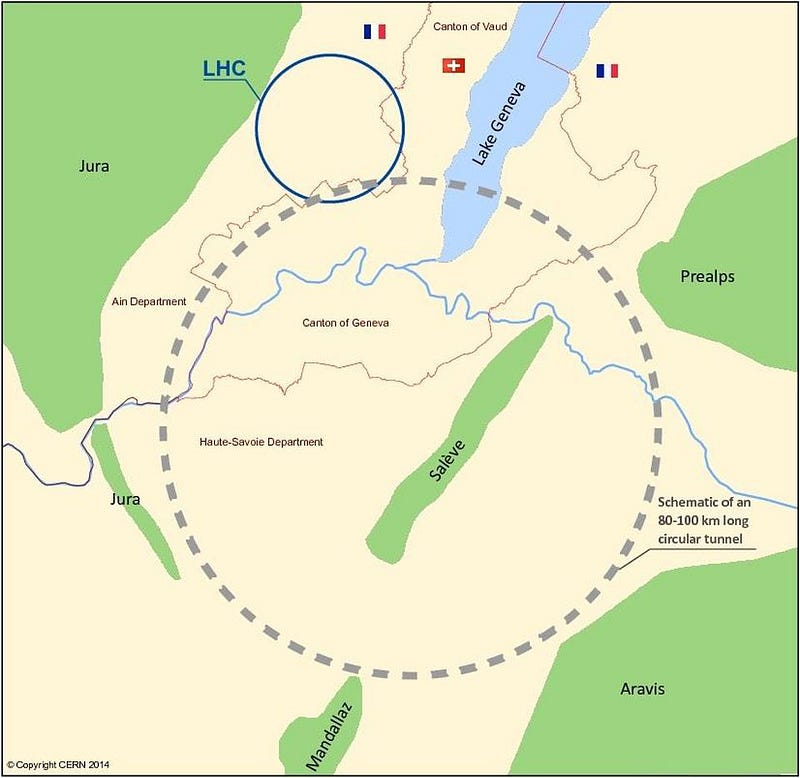
That is why we need a future collider. One that goes beyond what the LHC is capable of. And surprisingly, the next logical step isn’t to go to higher energies, but to lower ones with a far greater precision. That’s the first stage in the plans being floated at CERN for the FCC: the Future Circular Collider. Ultimately, a hadron-hadron collider, in the same tunnel, could break the 100 TeV threshold for collisions: a sevenfold increase over the LHC’s maximum energy. (You can play with an interactive app here to see what increases in energy and the number of collisions do to reveal the unexplored frontiers of physics.)
Most people don’t remember this, but prior to the LHC, that same 27-kilometer tunnel housed a different collider: LEP. LEP stood for the Large Electron-Positron collider, where instead of protons, electrons and their antimatter counterparts (positrons) were accelerated to incredibly fast speeds and smashed together. This came with both a huge advantage and a huge disadvantage over proton-proton colliders.
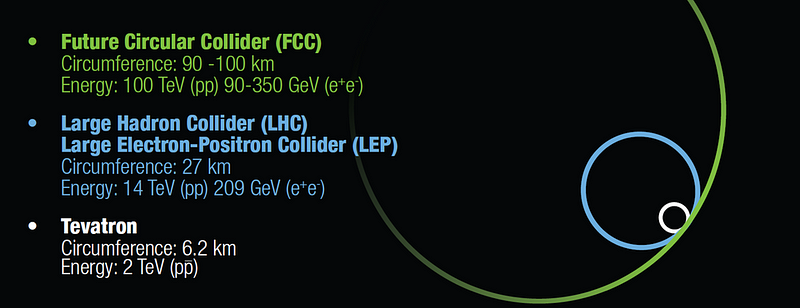
Electrons and positrons are almost 2000 times lighter than protons, which means they can get far closer to the speed of light than protons can at the same energy. LEP accelerated electrons up to maximum energies of 104.5 GeV, which translates to a speed of 299,792,457.9964 meters per second. At the LHC, protons reach far greater energies: 6.5 TeV apiece, or some 60 times greater than LEP’s energies. But their speed is just 299,792,455 m/s. They’re far slower.
The reason for the lower maximum energies for electrons and positrons are that their masses are so light. Charged particles radiate energy when they’re in magnetic fields, through a process known as synchrotron radiation. The greater your charge-to-mass ratio, the more you radiate, which caps your maximum speed. Electron-positron colliders are doomed to lower energies; that’s their disadvantage.
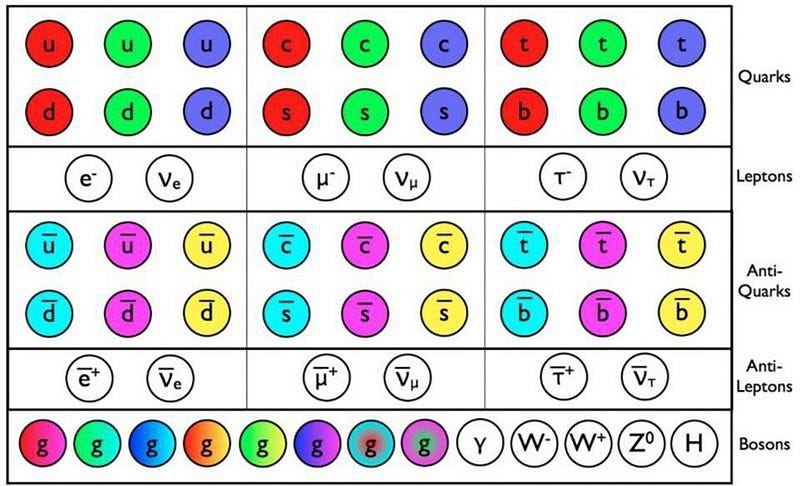
But their advantage is that the signal is perfectly clean. Electrons and positrons are fundamental, point particles. If you have an electron and a positron at energies of, say, 45.594 GeV apiece, then you can produce Z-bosons (of rest mass 91.188 GeV/c²) spontaneously and in great abundance. If you can tune your center-of-mass energy to equal the rest mass of the particle (or particle pairs, or particle-antiparticle pairs) you hope to create, via Einstein’s E = mc², you can basically build a factory for producing whatever unstable particles you want.
At a future collider, that means producing Ws, Zs, top (and antitop) quarks, and Higgs bosons at will. When you build a particle accelerator, its radius and the strength of its magnetic fields determine the maximum energy of your particles. With the proposed 100 km Future Circular Collider, even colliding simple electrons and positrons, we can make every particle in the Standard Model at will, in great abundances, as many times as we like.
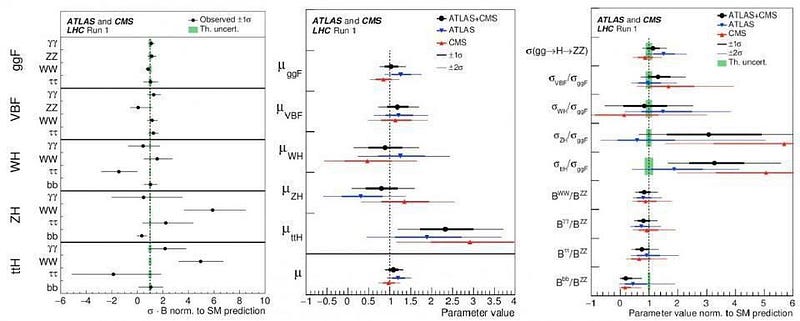
Even at lower energies than the LHC, a larger electron-positron collider has the potential to probe physics as never before. For example:
- If there are any new particles that exist below about 10 TeV in energy (and up to 70 TeV for certain classes of new physics), their indirect effects should appear in the production and decay of Standard Model particles, or the mass relations between them.
- We can further study how the Higgs couples with Standard Model particles, including itself, as well as beyond-the-Standard-Model particles.
- We can determine if there are additional “invisible” decays, where the products are unseen, beyond the Standard Model neutrinos.
- We can measure all the decays of short-lived particles (like the Higgs boson or the top quark, or even the b-quarks and τ leptons) to greater, unprecedented precision.
- We can search for, constrain, and in some cases rule out exotic particles, not just from supersymmetry, but from other scenarios, such as sterile neutrinos.
- And, potentially, we can even learn how the electroweak symmetry breaks, and what type of transition (involving quantum tunneling or not) breaks it.
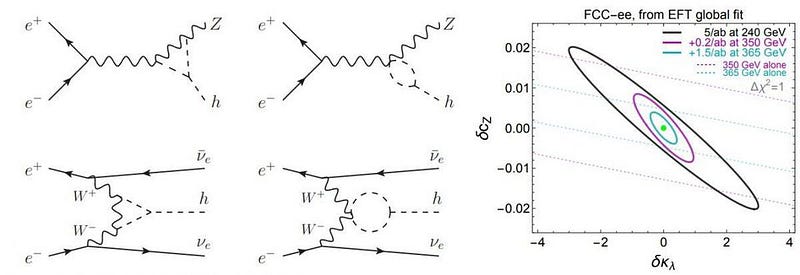
Before we ever consider a collider at higher energies, building a precisely-tuned collider capable of creating all the known particles in abundance is a no-brainer. There have already been considerable resources invested in a linear collider for electrons and positrons, like the proposed CLIC and ILC, but similar technologies would also apply to a large circular tunnel with electrons and positrons accelerating and colliding inside.
It’s a way to push the frontiers of physics to uncharted territory using technology that already exists. No new inventions are necessary, but the unique benefit of a future circular lepton collider is that it could be upgraded.
In the early 2000s, we replaced LEP with a proton-proton collider: the LHC. We could do that for this future collider as well: switching to colliding protons once the electron-positron data is collected. If there’s any hint of new, beyond-the-Standard-Model physics at the energies a future collider achieves — addressing problems from baryogenesis to the hierarchy problem to the puzzle of dark matter — the proton-proton collider will actually make these new particles.
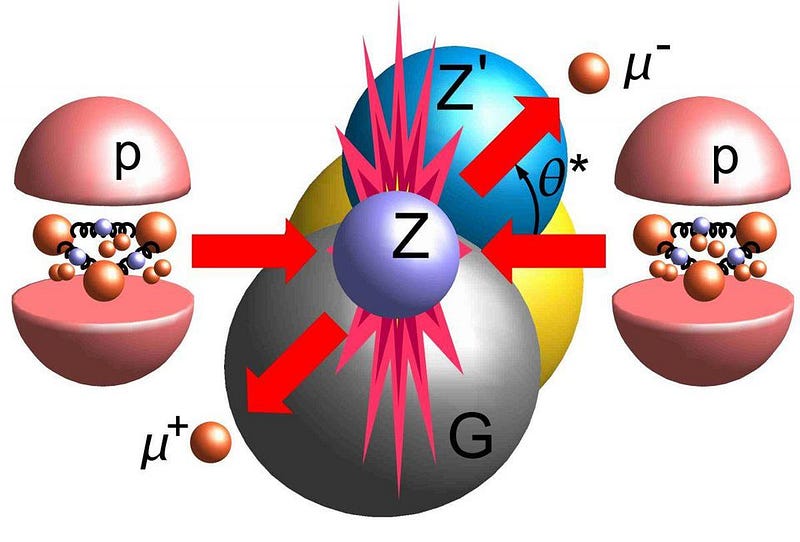
To understand the Higgs self-coupling even better, a ~100 TeV hadron-hadron collider will be the ideal tool, producing over 100 times the number of Higgs bosons than the LHC will ever create. A proton-proton version of a Future Circular Collider can use the same tunnel as the lepton-lepton version and will employ next-generation technology for its electromagnets, reaching field strengths of 16 T, which is double the LHC’s magnet strength. (These magnets will be a formidable technological challenge for the next two decades.) It’s an ambitious plan that allows us to plan for at least two colliders in the same tunnel.
https://www.youtube.com/watch?v=DaGJ2deZ-54
A future hadron-hadron collider at a Future Circular Collider will also measure rare decays of the Higgs boson, like decays to two muons or a Z-boson and a photon, as well as the Higgs-top quark coupling to ~1% precision. If there are new bosons, fundamental forces, or signs of baryogenesis at the electroweak scale or even a factor of ~1000 higher, the proposed proton-proton incarnation of the Future Circular Collider will find the evidence. Neither an electron-positron collider or the LHC can do this.
All told, the hadron-hadron version of the FCC will collect 10 times as much data as the LHC will ever collect (and 500 times as much as we have today), while reaching energies that are seven times higher than the LHC’s maximum. It’s an incredibly ambitious proposal, but one that’s within our reach by the 2030s, if we plan for it today.

There’s also a “phase III” that involves probing the frontiers of physics in an entirely different way: by colliding high-energy electrons, in one direction, with high-energy protons in the other. Protons are composite particles, made up of quarks and gluons on the inside, along with a sea of virtual particles. Electrons, via processes like deep-inelastic-scattering, are the best proverbial microscope for probing the internal structure of protons. If we want to understand the substructure of matter, electron-proton collisions are the way to go, and the FCC would push the frontier far past where previous experiments, like the HERA collider at DESY, have taken us.
Between indirect effects that an electron-positron collider might see, the direct new particles that might arise from proton-proton collisions, and the greater understanding of mesons and baryons that an electron-proton collider will bring, we have every reason to hope that some new physical signal might emerge.
What do we do next, then, if there is new physics there? What if there are new particles that are discovered at these higher energies? What next?

We don’t necessarily need to build an even bigger collider to study them better. If there is new physics up at a very high energy scale, we could probe it in depth with a potential “phase IV” for a Future Circular Collider: a muon-antimuon collider in the same tunnel. The muon is like an electron: it’s a point particle. It has the same charge, except it’s approximately 207 times heavier. This means some extremely good things:
- it can reach much higher energies by achieving the same speeds,
- it provides a clean, energy-tunable signature,
- and unlike electrons, because of the much lower charge-to-mass ratio, its synchrotron radiation can be neglected.
It’s a brilliant idea, but also a tremendous challenge. The drawback is singular but substantial: muons decay away with a mean lifetime of just 2.2 microseconds.
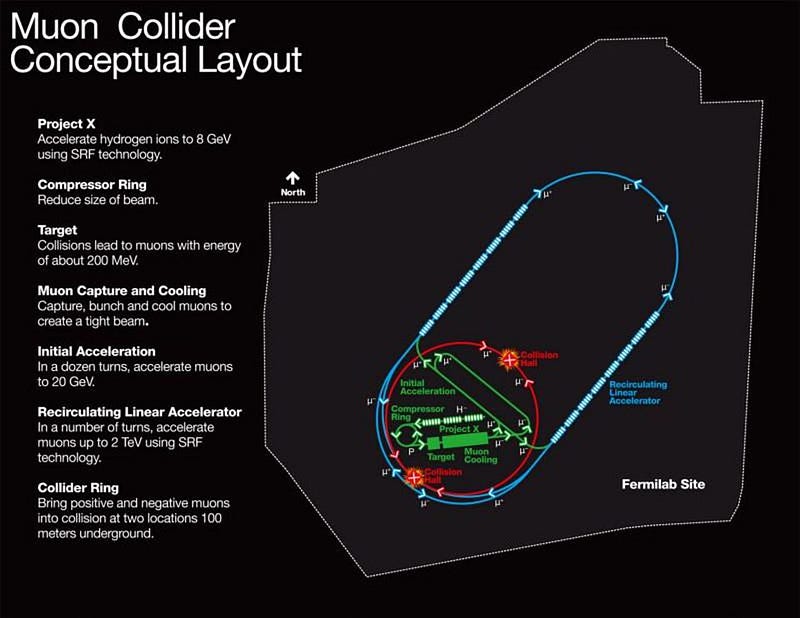
This isn’t a dealbreaker, though. Muons (and antimuons) can be made very efficiently through two methods: one by colliding protons with a fixed target, producing charged pions which decay into muons and antimuons, and a second by colliding positrons at right around 44 GeV with electrons at rest, producing muon/antimuon pairs directly.
We can then use magnetic fields to bend these muons and antimuons into a circle, accelerate them, and collide them. If we get them going fast enough in a short enough timescale, the time dilation effects of Einstein’s relativity will keep them alive long enough to collide and produce new particles. We could, in principle, reach energies of ~100 TeV with a clean signal in a muon collider this way: approximately 300 times as energetic as a future electron/positron collider.
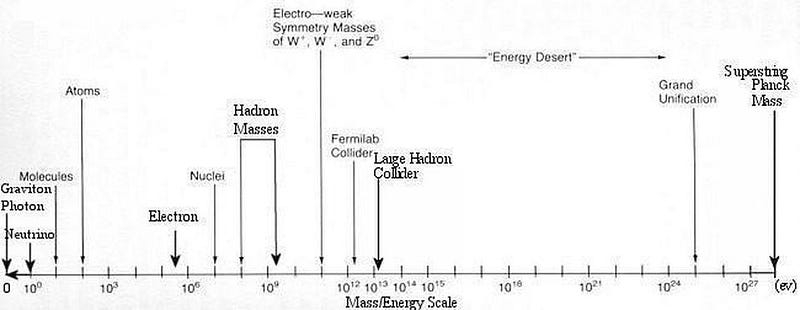
Prior to the discovery of the Higgs, we used the term “nightmare scenario” to describe what it would be like for the LHC to find the Standard Model Higgs and nothing else. Realistically, it is no nightmare to discover the Universe exactly as it is. There may not be any additional particles or anomalous, beyond-the-Standard-Model behavior to discover with any terrestrial collider we could possibly build, it’s true. But there could also be plenty of new, unexpected discoveries at scales and precisions that the LHC will be incapable of accessing.
The only way to know the truth about our Universe is to ask it these questions. Figuring out what the laws of nature are and how particles behave is a step forward for human knowledge and the entire enterprise of science. The only true nightmare would be if we stopped exploring, and gave up before we ever looked at all.
The author thanks Panos Charitos, Frank Zimmermann, Alain Blondel, Patrick Janot, Heather Gray, Markus Klute, and Matthew McCullough of CERN for incredibly useful, informative discussions and emails concerning the potential for a future, post-LHC collider.
Ethan Siegel is the author of Beyond the Galaxy and Treknology. You can pre-order his third book, currently in development: the Encyclopaedia Cosmologica.




